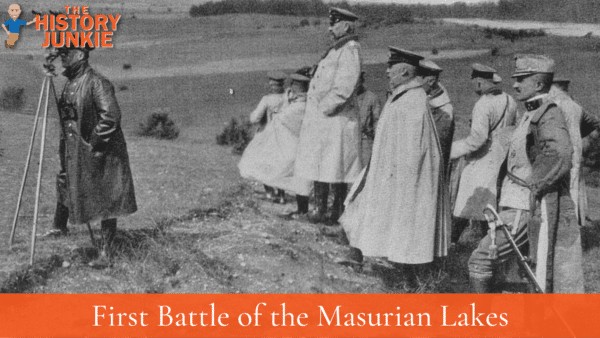The First Battle of the Masurian Lakes was a German offensive on the Eastern Front from September 2 to 16, 1914, during the second month of World War 1.

It took place just days after the Battle of Tannenberg, in which the German Eighth Army encircled and destroyed the Russian Second Army.
The Eighth Army used the rapid movements of the East Prussian railway network to reform in front of the spread-out Russian First Army.
Jump to:
The Germans then pushed the Russians back across their entire front, eventually ejecting them from Germany.
Further progress was hampered by the arrival of the Russian Tenth Army on the Germans' right flank.
Prelude
After defeating the Russian Second Army at Tannenberg, Paul von Hindenburg's Eighth Army, which consisted of 21 divisions, 18 of infantry and 3 of cavalry, turned its attention to the Russian First Army, commanded by Rennenkampf.
These two armies had been deployed as two arms of a pincer movement intended to encircle and destroy Hindenburg's forces in East Prussia. With one arm of the pincer now broken, Hindenburg was determined to neutralize the other as quickly as possible.
Hindenburg planned to encircle Rennenkampf by breaking through a weak flank of the latter's southern corps, which had belatedly moved south to support the Second Army at Tannenberg.
The southern corps had become somewhat separated from the main body of Rennenkampf's army, which had remained passive during the earlier battle.
Rennenkampf's army was currently moving through the Insterburg Gap between Konigsberg and the Masurian Lakes. However, upon receiving news of the Second Army's defeat, Rennenkampf ordered his forces to retreat to a firmer position extending from the Baltic southeast to Angerburg.
The Battle
On September 7, the German army launched a preliminary attack from either side of the southern lakes. The goal was to push the Russians up toward the coast.
The Russians were outnumbered 3-to-1, and their forces dispersed. The Germans continued their northward advance in pursuit of the main Russian army.
Rennenkampf, who feared being outflanked, authorized a further orderly withdrawal on September 9. He simultaneously ordered a counter-strike at the Germans by two divisions to hold up the German advance while his men pulled back.
Rennenkampf was successful in this, but by September 13, all Russian troops had retreated from East Prussia. Russian casualties were high: 125,000 compared to the German figure of at most 40,000.
The Germans could ill-afford such high losses in the east.
Aftermath
Yakov Zhilinski, the army group commander responsible for the Russian plan of invasion, was dismissed after the Russian army's perceived poor performance.
The Battle of Tannenberg and the First Battle of the Masurian Lakes resulted in two defeats of the Russian army.
The battles largely removed any threat to German forces stationed in East Prussia. However, a Russian counter-attack from September 25 to 28, 1914 (the Battle of the Niemen) forced a German retreat back to the border and resulted in the Russian army retaking much of the ground lost in the First Masurian battle.
As a consequence of Tannenberg and the Masurian Lakes, Hindenburg was hailed as a hero in Germany. He succeeded Erich von Falkenhayn as Chief of the German Staff in the late summer of 1916.
Despite Hindenburg's fame at home, his Chief of Staff, Erich Ludendorff, was the chief architect of these and future Hindenburg victories. Ludendorff followed Hindenburg to Berlin as his quartermaster general upon Hindenburg's promotion to Army Chief of Staff.
